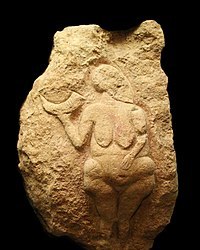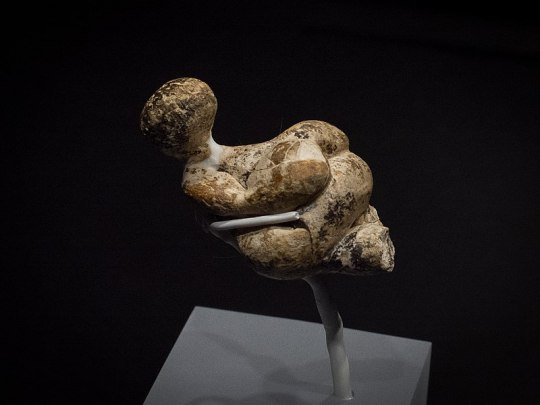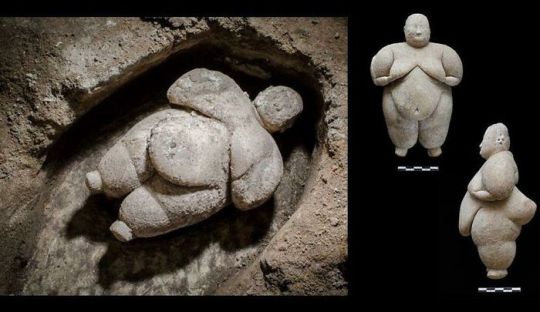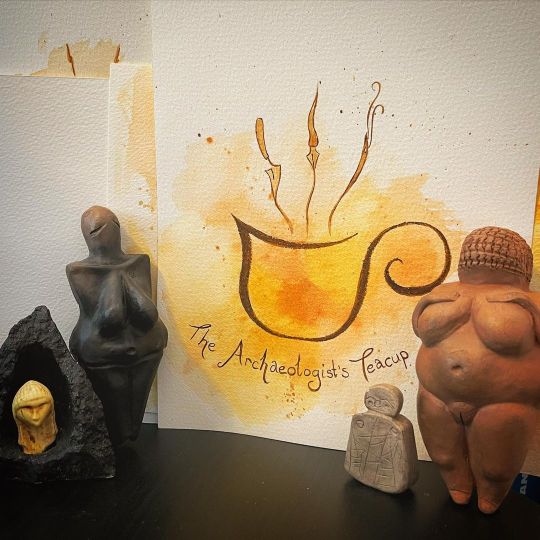#prehistoric venus
Explore tagged Tumblr posts
Text

A lovely female figure from Cussac Cave in France, about 25,000 years old.
194 notes
·
View notes
Text



The Orkney Venus, or Westray Wife, is a small figurine dating from the Neolithic period found on Westray in the Orkney Islands. In real life she is a tiny female figure, sculpted from sandstone and only a couple of inches high. Historians are unsure of her meaning, but she has been compared to other 'Venus' figurines found throughout Europe.
This tiny pendant is a faithful replica of the figurine, complete with tiny carved detailing. It is handmade from recycled solid silver, and is lightweight and comfortable for everyday wear.
Order your own HERE
#silver#silver jewelry#silver jewellery#handmade jewelry#etsy#etsyseller#orkney#orkney venus#westray wife#scotland#celtic#pagan#silver clay#prehistoric#history
16 notes
·
View notes
Text

Drawing Venus of Willendorf ✨ - a c.30,000 years old, 11cm (4.4”) tall statuette currently in the Natural History Museum of Vienna, Austria, this statue shows a beautiful early capture of the female form.
I drew this from reference (ofc!) using procreate as part of a series of archaeological drawings I’m doing to practice digital sketching and painting.
#artwork#art#digital art#digital illustration#painting#digital painting#procreate#self taught artist#history#archaeology#venus#prehistoric#prehistory
21 notes
·
View notes
Text





Aphrodite Paphia (of Paphos)
A conical basalt stone from the [pre-Greek] Sanctuary of Aphrodite, Palaepaphos site, Cyprus [birth of Venus' from Sea foam site]
Different populations of Cyprus worshiped a female divinity from as early as the Chalcolithic period (3900–2500 BC). The cult-site is active through the Late Bronze Age (c.1200 BC) to the end of the 4th century AD [Phoenician, Archaic, Classical, Hellenistic and Roman]
Valid scientifically evolution of Astarte (Mesopotamian) or Ishtar (Akkadian), great goddess of ancient Middle East.
The deity's representation (from recovered archeological relics) was of steatopygian female form (fertility figures)
Old Paphos (Palaepaphos), was settled by Greeks in the Mycenaean period, ca. 1600 to 1100 B.C.
Paphos was the offspring of Pygmalion and Galatea, the "milk-white" sculpture brought to life by Aphrodite.
According to Ovid, Cypriot sculptor Pygmalion detested the Propoetides' ways of practicing prostitution, and set a famous case of Agalmatophilia.
According to Pausanias, Aphrodite's worship was introduced to Paphos (Cyprus) from Syria, and from Paphos to Kythera in Greece
Some sources claim that the first priest was king Cinyras (according to Strabo, a previous ruler of Byblos in Phoenicia) [his (Cinyrad) dynasty ruled Paphos until its conquest by Ptolemy I of Egypt (294 BC)].
The adoration of Venus was particularly intense in the ancient period with religious ceremonies depicted on vases or bronze vessels. Common offerings to Venus were myrtle tree branches or essential oil [possibly linked to the blood of Adonis and the teardrops of Venus]
Representations on ancient ceramics depict people in a garden, amongst bushes, flowers and birds.
https://en.wikipedia.org/wiki/Sanctuary_of_Aphrodite_Paphia
https://www.hist.uzh.ch/de/fachbereiche/altegeschichte/assoziierteforschende/vonwartburg/forschungsprojekte/paphos/projects/aphrodite-at-paphos.html
https://www.polignosi.com/cgibin/hweb?-A=12594&-V=limmata
https://www.polignosi.com/cgibin/hweb?-A=7335&-V=limmata
https://www.cyprusisland.net/attractions/palaipaphos-kouklia-archaeological-site
https://en.wikipedia.org/wiki/Kouklia
https://www.britannica.com/topic/Aphrodite-Greek-mythology
https://en.wikipedia.org/wiki/Cinyras
https://www.britannica.com/topic/Astarte-ancient-deity
12 notes
·
View notes
Text
The source of the materials used to make the Venus of Willendorf, a 30,000-year-old figurine that counts among the world’s oldest artifacts, have long eluded experts. The figurine, which resembles a woman with fulsome breasts and round hips, is made of a rock known as oolite, which isn’t native to Willendorf, the village in Austria where it was found. At long last, how the oolite made its way to Willendorf appears to be solved.
An anthropologist with the University of Vienna and two geologists said on Tuesday that the Venus of Willendorf’s oolite most likely came from an area in the north of Italy near Lake Garda. The findings by Gerhard Weber, Alexander Lukeneder, and Mathias Harzhauser put forward in their paper, which appears in the peer-reviewed journal Scientific Reports, have the potential to reshape how experts understand the movement of various peoples during the Paleolithic era.
Working in collaboration with the prehistorian Walpurga Antl-Weiser and the Natural History Museum in Vienna, which owns the Venus of Willendorf, the team of researchers closely examined the figurine to determine its origins. They relied on a technique called micro-computed tomography, which uses extremely high-definition photography to offer cross-sections of objects.
Inside the oolite, they discovered remnants of shells and limonites, a kind of large grain. Some of the limonites appear to have fallen out of the figurine as it was being carved, leaving depressions behind. The experts suggested that the Venus of Willendorf’s gaping belly button was the result of this—a happy accident that was embraced by its maker.
If indeed the oolite came from northern Italy, it means that the sculpture’s maker likely traveled across an area where the Alps are sited. But because glaciers that have since melted once covered those mountains, the creator likely circumvented the Alps.
Because the oolite went from Italy to Austria, it probably means that the people of civilization that the sculpture’s maker belonged to “looked for and inhabited favorable locations,” Weber said in a statement. “When the climate or the prey situation changed, they moved on, preferably along rivers.”
But the archaeologists left open the possibility that the oolite may have come from a very different locale: Ukraine. Similar-looking Venus figures have been found there, the experts said, and while the oolite “clearly” seems to have come from Italy, it was “possible, though less likely,” that this sculpture could have originated in Eastern Europe.
#studyblr#history#prehistory#art#art history#prehistoric art#sculpture#science#geography#geology#paleolithic#austria#italy#ukraine#niederösterreich#lombardia#veneto#wachau#willendorf#lake garda#alps#venus of willendorf#oolite#limonite#glaciers
6 notes
·
View notes
Text

"The so-called "Venus of Kostenki" was recovered from one of the Paleolithic sites on the Don River in Russia. Several figurines from this area share the same traits and indicate a single goddess who is encountered not just in Russia but throughout prehistoric Europe and the Near East.
Her commonalities in so many figurines include the largeness of breasts, belly, thighs, and buttocks; a globe of a head with closely plated hair or more likely a knitted cap; and arms folded under breasts.
Of subtler recurrence, least often remarked upon but of signal importance, is how often her head is tipped downward, not skyward, for the afterlife is not in the sky but in her own womb, the womb of the fatted earth. She is additionally faceless, as the Goddess in her wholeness is unknowable.
This is the standard appearance of the Kostenki goddess figurines; but how nearly identical she is to prehistoric figurines from France to Israel is what startles. It is now known that a series of prehistoric societies were extremely far-ranging in their influences, amounting to a vast society of roaming hunter-gatherers.
The last of these cultures has been named the Gravettian, the mammoth hunters who built sturdy shelters of mammoth bones to stand against even Ice Age storms, or dwelt in caves or semi-underground habitations. They were not a settled culture but did have centers revisited seasonally or periodically, ritual sites or encampments along the trails of migratory animals.
Gravettian art dates from 25,000 to 20,000 BCE or older in Europe (and the Kostenki sites in use from about 37,000 BCE). This surprisingly was a unified culture that lasted a minimum of 5,000 years, with lingering elements until 17,500 BCE, and influences on the following Epigravettian era in Spain, Italy, France, the Balkans and Ukraine.
Their goddess figurines were small because a nomadic existence required portability. When the Ice Age ended, Gravettian culture begins its slow fade into settled agricultural societies, the first cities, the earliest of which still created heavy-set faceless goddess figurines."
~ Jessica Amanda Salmonson
#Venus of Kostenki#figurine#ancient ways#sacred ways#goddess#goddess figurines#Gravettian culture#Jessica Amanda Salmonson#Paleolithic#Don River#Russia#Kostenki goddess figurines#37000 BCE#Epigravettian era#Spain#Italy#France#The Balkans#Europe#Prehistoric
7 notes
·
View notes
Text

8000-year-old prehistoric Venus figurine made of terracotta named "Red hair goddess", excavated at Donja Branjevina archaeological site in Deronje village, Bačka region, Vojvodina province, northern Serbia.
34 notes
·
View notes
Text

they kind of look like gingerbread men... gingerbread men distribution O.O
#magdalenian culture#paleolithic#epipaleolithic#mesolithic#prehistoric europe#prehistory#venus figurine#female figurine#my upl#archaeology
6 notes
·
View notes
Text

Venus de Willendorf o Venus Paleolítica
#Venus of Willendorf#venus#venus paleolítica#paleolithic#paleolithic art#paleolithic venus#stone age#history#prehistoric#ancient history#paleolithic idol#isn't she cute?
11 notes
·
View notes
Text

LA VENERE DI WILLENDORF: La venere di Willendorf è una statuetta delle dimensioni di 11 centimetri di altezza ritrovata a Willendorf (in Austria) nel 1908. E' una delle testimonianze più antiche dell'arte paleolitica, risale infatti a 30 mila anni fa. Le dimensioni e la mancanza di un piedistallo fanno credere che avesse una funzione simile a un portafortuna. Le sue forme sproporzionate inoltre rimandano alla fertilità femminile, probabilmente anch'essa aveva uno scopo propiziatorio. Il luogo di conservazione attuale è il Naturhistoriches museum a Vienna.

Curiosità: La venere di Willendorf non è l'unica statuetta nel suo genere, infatti sono state ritrovate numerose opere con gli stessi segni iconografici ma in diverse parti dell'Europa. Nel paleolitico è impossibile che popoli così lontani tra loro potessero avere contatti, dunque come molti avessero un culto comune resta ancora oggi un mistero.
2 notes
·
View notes
Text
Venus Figurine Appreciation Post
(for the unaware, these are female (in the sense of assigned sex, not gender) human figurines from the Upper Paleolithic period. They were made between 35,000 and 11,000 years ago all over Eurasia. This specific list of figurines has been curated based solely on my personal artistic preferences.)


The Venus of Holde Fels, the oldest Venus figurine ever found

Venus of Dolni Vestonice - my personal favorite

Venus of Willendorf, arguably the best known

The Venus of Laussel is actually a stone relief, not a figurine, but still cool

Venus of Lespugue

Venus of Moravany

One of several Venuses of Kostyonki

One of several Venuses of Gagarino
This concludes the Venus Figurine Appreciation Post.
#hylian rambles#venus figurines#prehistoric art#uncaptioned#artistic nudity#i am NOT community labeling art of human bodies but we'll see if the tumblr filter catches it anyways#human bodies shouldn't be censored in my opinion. they're just bodies. we all have them.#archaeology#if you're noticing a trend that all of these are fat it's not because all venus figurines are like that. although many if not most are.#it's because i thought the skinny ones were less artistically appealing#not that skinny people can't be artistically appealing. these particular figurines simply did not speak to me
5 notes
·
View notes
Photo


1 artists unknown “venus figure” c12,000 BCE black steatite
2 artist unknown Venus of Willendorf c25,000 - 28,000 BCE stone 11.1cm
The Venus figurines is a term given to a collection of prehistoric statuettes of women made during the Paleolithic Period, mostly found in Europe, but with finds as far as Siberia. To date, more than 200 of the figurines have been found, all of whom are portrayed with similar physical attributes, including curvaceous bodies with large breasts, bottoms, abdomen, hips, and thighs, and usually tapered at the top and bottom. The heads are often of relatively small size and devoid of detail, and most are missing hands and feet. Some appear to represent pregnant women, while others show no such signs. There have been many different interpretations of the figurines, but none based on any kind of solid evidence. Like many prehistoric artifacts, the cultural meaning may never be known. ancient-origins.net
3 notes
·
View notes
Photo
This is why I don't let anyone tell me I don't have the body of a goddess

An 8,000-year-old marble figurine of a voluptuous woman was unearthed in 2016 in the Neolithic urban settlement of Çatalhöyük in central Turkey. The figurine is 17 centimeters long, 11 centimeters wide and weighs one kilo.
#prehistory#prehistoric art#catalhoyuk#beauty#fat pride#pcos#chronic weight gain#obese me#venus of willendorf#i have the body of a goddess
26K notes
·
View notes
Text
very funny to imagine the prehistoric women depicted in "venus figurines" being told they are "morbidly obese" by modern physicians. listen to me neolithic matriarch. you are fat. hunting wild game and knapping flint axes and walking 4 miles a day is not enough exercise. you have prediabetes and need to eat under 1500kcal or you will die. tsk tsk. your sleep hygiene is bad. you look at the fire too much at bedtime
15K notes
·
View notes
Photo

Happy International Women's Day! . Some of the most well known women from the past are the famous "Venus Figurines" that are found all over the world from as far back as the Paleolithic. The exact significance of these figurines is still a matter of discussion, as is the appropriateness of the name itself, and whether all of these beautifully diverse figurines should be lumped into one typological category. . If you're interested in learning more about those figurines depicted in this post, check out the past #TeaDay reels (also shared in stories!). Left to right: Venus of Brassempouy, Venus of Dolní Věstonice, Orkney Venus, Venus of Willendorf. . What's your favourite (pre)historic depiction of women? . #InternationalWomensDay #VenusFigurine #Venus #VenusOfWillendorf #VenusOfDolniVestonice #WestrayWife #OrkneyVenus #WomenOfPrehistory #WomenOfThePast #FemalePower #archaeologist #ArchaeologyLovers #ArchaeologyLife #prehistoric #prehistory #ArchaeologistsOfInstagram https://www.instagram.com/p/Cph3W4aqq_k/?igshid=NGJjMDIxMWI=
#teaday#internationalwomensday#venusfigurine#venus#venusofwillendorf#venusofdolnivestonice#westraywife#orkneyvenus#womenofprehistory#womenofthepast#femalepower#archaeologist#archaeologylovers#archaeologylife#prehistoric#prehistory#archaeologistsofinstagram
0 notes
Text
yeah women being feminine and societal gender expectations until venus of berechat ram struts in. no one breathes. she's the ideal woman:

0 notes